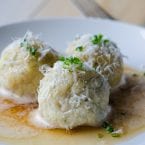Description
Italian dumplings, or canederli, are a delicious way to use up stale bread. Learn how to make them and serve in a brown butter sauce or soup broth.
Ingredients
Scale
- 8 ounces stale white bread (cut into 1/4 inch dice)
- 1 1/2 cups milk
- 1 tablespoon butter
- 1/2 onion (minced)
- 1/2 leek (minced and rinsed well)
- 2 tablespoons fresh Italian parsley (minced)
- 4 ounces speck (diced)
- 2 eggs (beaten)
- 1/4 cup to 1 cup flour (plus more for dusting)
- Kosher salt and freshly ground pepper
- 8 cups good beef or chicken stock
Instructions
- Place the bread in a large bowl and add the milk. Stir to combine, and season with salt and pepper. Allow to rest for an hour, stirring occasionally to make sure the bread is uniformly moist.
- Meanwhile, melt the butter in a saute pan over medium heat. Add the onion and leek and cook until translucent and soft, about 4 minutes. Allow to cool.
- After the bread mixture has rested, add the onion-leek mixture, the parsley, speck, and the eggs and thoroughly mix the ingredients with your hands, breaking up any larger pieces of bread and making sure the speck, parsley and onions are evenly distributed.
- Then begin to add the flour, 1/4 cup at a time, stirring to combine everything. The final amount of flour will depend on how dry the bread is, the type of bread, the size of the eggs. It will begin as more of a batter, sticking to the sides of the bowl more than itself. It will stiffen as you add more flour, beginning to clump together in a large ball. In the end, the mixture should be uniformly moist, and still a little sticky. If it is very sticky, add a bit more flour.
- Using your hands coated with flour, form the canederli by pressing the mixture into balls, about the size of a clementine. Roll each ball lightly in flour, shake off the excess and place on a sheet pan, leaving room between each so they do not stick. If they do not hold their rounded shape fairly well, and instead flatten immediately, you probably need a bit more flour.
- If you have not made these before and are unsure of the consistency, you can test one at this point before forming all the dumplings. Poach the first one in a pan of boiling water for 10-12 minutes. If it does not hold together, a bit more flour might be required. This is not an exact science – make them how you like them!
- When ready to serve, bring the broth or water to a simmer in a large pot. Place the canederli into the simmering liquid and poach for 12 minutes or so. They will sink to the bottom at first; stir them occasionally so they don’t stick to the bottom. Eventually they will float to the top.
- For Canederli in Brodo: Spoon the canederli and broth into bowls, top with grated grana cheese and minced chives, and serve immediately. Note that the broth will be cloudy from the flour that coats the canederli. If you prefer a nice clear broth, poach them in broth or water which you then discard, and use fresh hot broth to serve.
- For Canederli in Burro: Remove the canderli from the poaching liquid and keep warm. Melt 1/4 cup butter in a saute pan until brown and nutty. Place 3 canederli onto each plate, pour the browned butter over them, then sprinkle with some minced chives, grated grana cheese, and freshly ground black pepper. Or add some chopped sage when browning the butter.
- Category: Main
- Cuisine: Italian
